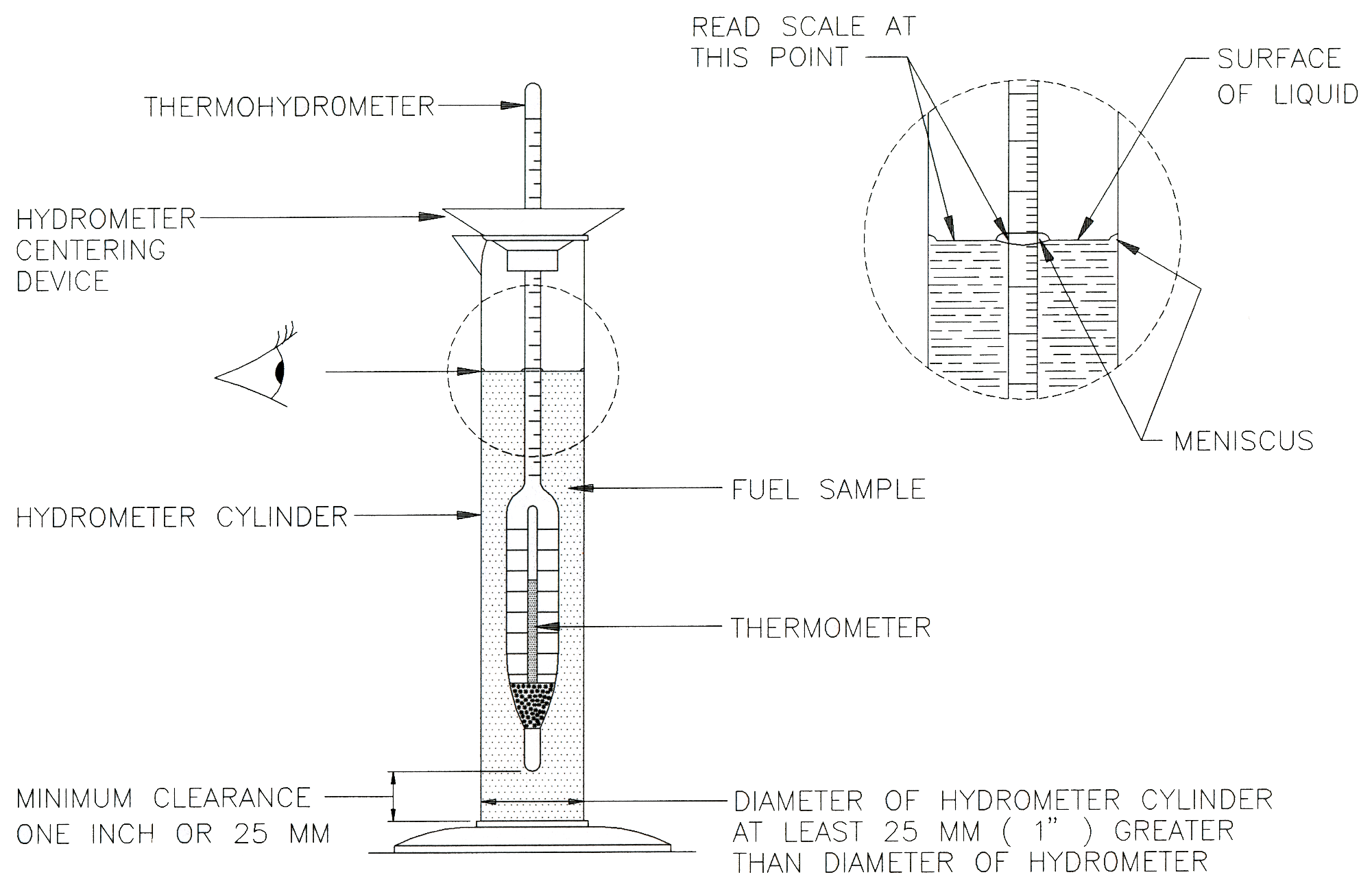Recently, an oil company employee telephoned to inquire if we would sell him a hydrometer that would not require him to measure the temperature of fuel when he wanted to determine the gravity of his jet fuel. I pointed out to him that while it might be possible to make a computerized hydrometer that would automatically compensate for temperature variations, it would surely cost many times more than the common hydrometer costs today. This strange telephone request is simply one of a long series of questions from people who do not seem to understand the concept of fuel gravity (weight). Isn’t it strange today that there are so many people who do not understand a subject that was quite elementary to our great-grandfathers who drove around in Model T Fords, and carried hydrometers with them at all times in order to determine whether or not they were getting the right fuel for their automobiles? This is reverse progress!
The trend in the United States, and in some other parts of the world, is to have fuel dealers assume all of the responsibility for the handling of aviation fuel. These people who never previously had to worry about fuel gravity now find they must understand this concept; the number of misunderstandings that we encounter is quite astonishing. The purpose of this GamGram is to review the entire subject of gravity, and also to explain the differences between API Gravity, Specific Gravity, Relative Density, Density and Fuel Weight.
All of these measurements are simply ways to describe the weight of a fuel. Airplane engines do not really care very much about the gravity of fuel that is to be burned. The reason that we measure the gravity or the weight of fuel is because this is a simple measurement that can help to identify a fuel. If we find the Relative Density of a fuel is 0.84, we can be sure that it is not jet fuel because it is too heavy. It may very well be diesel fuel or #2 fuel oil. On the other hand, if the oil company has told us that a shipment of jet fuel has an API Gravity of 45° and we find that it measures 49°, we have reason to suspect that the fuel has been contaminated with some other material, even though it is still within the limits of gravity for jet fuel.
Before going farther into the subject of gravity, we should first explain the different methods for measuring it.
- RELATIVE DENSITY (formerly known as Specific Gravity) – The ratio of the weight of a fuel divided by the weight of water, both at a standard temperature of 60°F. A fuel that has a Relative Density of 0.84 is simply a fuel that has 84% of the weight of water. If the fluid is heavier than water, the Relative Density is more than 1. If it is lighter than water, the Relative Density is less than 1.
- API GRAVITY – Many years ago, the American Petroleum Institute adopted the idea of an arbitrary 0-100 scale to cover from the heaviest to the lightest oils and fuels. On this scale, gravity is expressed as “degrees API,” but “degrees” does not refer to temperature – it is just a way of saying it. Temperature must also be measured. As in Relative Density, the standard temperature is 60°F.
Note that the API scale is backwards from Relative Density. In other words, a high API Gravity number is very light fuel while a very low API Gravity number is an extremely heavy fuel. - FUEL WEIGHT – The gravity of fuel can be determined directly as pounds or kilograms. This is usually the kind of measurement that a pilot is most interested in, because he must be sure that he does not overload the airplane with too much fuel if he is carrying heavy cargo. Obviously, he must be sure of having enough fuel to get where he wishes to go but he does not want to carry weight needlessly, nor does he want to “bend” his wings by exceeding the maximum gross weight allowed for his aircraft. This measurement does not have a standard temperature, as will be found later in this article.
- DENSITY – This is metric weight. The terms are kilograms per cubic meter (formerly grams per cubic centimeter) and the standard temperature is 15°C.
Why do we talk about temperature when we are discussing gravity or weight of a fuel? The answer is simply that the fuel expands or contracts as the temperature increases or decreases. A gallon of jet fuel can weigh 6.58 lbs. at 100°F but a gallon of the same fuel will weigh 6.91 lbs. at 0°F. If the refinery reports that they produced a batch of jet fuel with an API Gravity of 43.8° you know this is the 60°F value. If you test the API Gravity with a hydrometer at 85°F, you must correct your reading to 60°F using a book of Correction Tables. In this case, if the fuel had not been contaminated with some other fuel, the hydrometer would have measured 46° API at 85°F instead of 43.8°.
To select the right hydrometer, the following table can be used to find the correct ASTM number designation. For example, if we want to measure API gravity of Avgas, ASTM hydrometer 7H or thermohydrometer 57HL are the best choices. A thermohydrometer has a thermometer built within it so that a separate thermometer is not needed.
How to Select the Correct Hydrometer
* Denotes the dominant range for type of fuel indicated.
| Fuel | API | Hydrometer | Thermo-hydrometer | Metric Density | Hydrometer | Thermo-hydrometer |
|---|---|---|---|---|---|---|
| JET A, JET A-1, JP-5, JP-8 | 29-41 39-51* |
4H 5H* |
54HL 55HL* |
800/850 750/800* |
315H 314H* |
304HL 303HL* |
| JET B, JP-4 | 39-51 49-61* |
5H 6H* |
55HL 56HL* |
750/800 700/750* |
314H 313H* |
303HL 302HL* |
| AVGAS | 59-71* 69-81 |
7H* 8H |
57HL* 58HL |
700/750* 650/700 |
313H* 312H |
302HL* 301HL |
Let’s go through a gravity determination step by step so that we can see exactly how it is done. We collect a sample of the fuel to be tested and put it in a hydrometer jar, which is simply a tall glass or plastic container. We carefully wipe off the hydrometer and then place it in the fuel. The hydrometer sinks into the fuel until it floats. Do not drop the hydrometer into the fuel because fuel adhering to the stem will be excess weight. Prevent it from sinking any more than two scale divisions beyond its limit. If the fuel is heavy, the hydrometer sinks very little. If the fuel is light, the hydrometer sinks more deeply.
Remember that the ancient Greek, Archimedes, said that an object is buoyed upward by a force equal to the weight of fluid that is displaced. So we see that the word “hydrometer” is just a fancy name for a float that has a measuring scale on it so that you can determine how far it has sunk into the fluid. It is a “hydro meter.” You read the scale on the hydrometer stem exactly where you see the surface of the fluid. Do not read at the top of the meniscus. To do this with the greatest accuracy, it is recommended that you set the eye slightly below the level of the liquid and then raise it to the exact level in the cylinder before taking the reading.
It is extremely important that the hydrometer not be read if it is touching the wall of the cylinder. To avoid this, try to rotate the hydrometer gently or you can phone Gammon Technical for more information on the Colrud Centering Device (GTP-8401). If bubbles are on the surface of the fuel, remove them with a strip of paper toweling.

You may use a separate thermometer or you may use a thermohydrometer, also known as a “combined form” hydrometer because it has a built-in thermometer. So now you have two numbers, the gravity as indicated by the hydrometer and the temperature as indicated by the thermometer. You must now go to a book of Correction Tables which are jointly published by the American Petroleum Institute and the American Society for Testing Materials.
The following table shows the correct table to use for each of the various measurement methods:
| Measurement | ASTM Hydrometer Correction Tables |
|---|---|
| Density, metric, kg/m3 | Volume VII Table 53B |
| API gravity, degrees | Volume II Table 5B |
| Relative density | Volume V Table 23B |
Suppose we measured 43.5° API at 46.5°F. We must use Table 5B. The combination of our two measurements is found on page 155 which is reproduced, in part, below. The corrected gravity at 60°F is read as 44.7° API.

In this example, if you had found that your corrected measurement was more than 0.3° API different from a previous report at the same location, you should check it again and/or report it for further investigation. Contamination is suspected. The approximate equivalents of 0.3° API are 1.3 kg/m³ in metric density of 0.0013 relative density.
In a situation where the gravity measurement at a delivery location (e.g. an airport) is being compared to a reported gravity at the point of shipment (e.g. a supply terminal), it is standard practice to expect the corrected gravities to be within 1° API.
Returning to the subject of fuel weight, most pilots are thoroughly confused when they are presented with gravity data that may have been temperature corrected. For example, if we tell a pilot that he has been fueled with jet fuel having an API gravity of 48.3° corrected to 60°F, we have really told him exactly nothing about the number of pounds or kilograms of fuel that is aboard the aircraft. If you pump 5000 gallons of this fuel aboard an aircraft at 40°F, its weight is 33,114 pounds. But if you delivered the same fuel at 90°F, the weight would be only 32,230 pounds. This is why pilots like to be given gravity data in pounds/gallon or kg/L at the actual fueling temperature. If you give them gravity data reduced to 60°F, a difficult series of calculations must be made to find actual weight, unless you have a Gammon Model GTP-3012-1A calculator.
There is another very important use for hydrometers that has not been discussed so far. This is in controlling the transfer of ownership of large quantities of fuel. For example, a tanker that is loaded with fuel at a port in a very hot climate will have much less volume of fuel aboard it when it arrives many days later at a port in a very cold climate. If fuel were to be sold on the basis of gallonage or volume, substantial losses would result from this kind of transaction.
In conclusion, we urge aviation fuel handling people to think of gravity as a quality control tool. It can be used to identify incorrect fuels and it can be used to determine when one fuel has been contaminated or mixed with another fuel.

